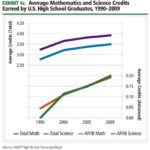U.S. Trends
NAEP
2013 – NAEP


In addition to participating in TIMSS, the United States also carries out the National Assessment of Educational Progress (NAEP) to assess elementary and secondary students in the United States on subjects including mathematics and science. In October 2013, NCES released the NAEP-TIMSS Linking Study, allowing comparison of U.S. states against international standards.
2012 – NAEP


The production of highly skilled scientists and engineers has its foundation in student performance during early education at the primary and secondary levels. Long-term trends in these areas show that students’ mathematics performance in the United States has been slowly improving over the past three decades.
2011 – NAEP – Snapshot
STEM achievement in primary and secondary schools is an indicator of how well the United States is ensuring that students are later prepared to pursue STEM degrees, enabling them to enter the space workforce. Every two years, the U.S. National Center for Education Statistics (NCES) National Assessment of Educational Progress (NAEP) uses standardized tests to rate the mathematics and science proficiency of fourth- and eighth-grade students.
2008 – NAEP
Starting at the 4th grade level, only 39% of students tested proficient or higher in mathematics in 2007, according to the National Assessment of Educational Progress (NAEP), also known as the Nation’s Report Card. . .